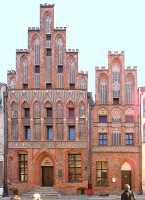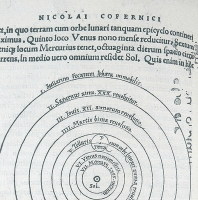Nicolaus Copernicus
Nicolaus Copernicus, De revolutionibus orbium coelestium libri VI. Nuremberg, 1543
Nicolaus Copernicus’ “On the Revolutions of the Celestial Spheres”, the most valuable book ever written by a Pole, auctioned off for over two million dollars! The greatest scientific work of the renaissance culture. Facsimile edition of the first edition, modeled after one of the eleven original copies found in Poland. From the Königsberg collection of Duke Albert of Prussia.
Limited Edition: 399 copies
Available: less than 8 copies
Nicolaus Copernicus, De revolutionibus orbium coelestium libri VI. Nuremberg, 1543
 Dr. Owen Jay Gingerich
Dr. Owen Jay Gingerich
more >>
 Download folder
Download folder
Copernicus’ heritage has acquired quite an ample bibliography. Among it, works dedicated to the greatest work of his life, De revolutionibus orbium coelestium libri VI, have a prominent place. Though there are fairly few studies discussing them in the bibliopolical aspect, i.e. registering the individual features of the surviving copies of the 16th century editions of this work with bookplates in the first position. In 1970 Owen Gingerich decided to fill this gap, which was particularly palpable in studies over the history of the reception of the heliocentric theory. He undertook an extremely painstaking and time-consuming search for the surviving copies of the 1st and 2nd edition of De revolutionibus from 1543 (Nürnberg, Joh.Petreius) and 1566 (Basel, Henricpetri). The search, conducted in famous and lesser libraries, not without incident so compellingly recounted by professor Gingerich, gave very interesting results. Gingerich registered over 250 copies of the first edition. This is at least half of the print- run estimated for 400- 500 copies.
This number includes the 12 twelve copies found in Poland or one copy less, if the print from the Library of the Polish Academy of Sciences stolen in November 1998 was smuggled out of Poland. The most interesting copy in terms of provenance and artistic features is the one held in the collection of the Library of the University of Toruń – reference number Pol.6 III.142.
Historical Background
 Nicolaus Copernicus
Nicolaus Copernicus
more >>
It was brought to Toruń already after World War II, at the end of the 1940s together with a batch of books from the so-called Nova Library, also known as the Castle Library, the oldest foundation of the State and University Library in Königsberg. The origins of this library, which was so named to juxtapose it against the old library of Duke Albert called the Deutsche Liberei or Kammerbibliothek, can be traced to the purchase of 68 books in 1529 by Crotus Rubeanus, the secretary of the Prussian ruler, know better as the co-author of Epistolae obscurorum virorum. As intended by its founder, this library was to serve as a scientific library for the scientific community of Königsberg, and after the founding of the University in Königsberg in 1544 also as an academic library. These plans were realized consistently. After collecting around one thousand tomes in 1540, the library was opened to the public. It is worth mentioning that the opening ceremony was honored with a poetry reading by the professor of the gymnasium from Elbląg, Wilhelm Gnapheus – the author of rather poor plays, including Morosophus, where he supposedly ridiculed the Copernican theory, outlined by Georg Joachim Rheticus in Narratio Prima (Gdańsk, F. Rhode 1540).
 House of Nicolaus Copernicus in Toruń (Poland)
House of Nicolaus Copernicus in Toruń (Poland)
more >>
It is fairly easy to notice the common passion and strong scientific and emotional relationship between Rheticus and Copernicus. Both scientists were set apart by a considerable age difference (41 years), nevertheless, Copernicus trusted the young mathematician with his entire scientific accomplishments in the form of just one manuscript of De revolutionibus…, obviously, with the intention of having it printed by Petreius. Supposedly, as evidenced by the cleanliness of the manuscript, it was not used as a template in the print shop. It bears no marks of inks, stains or dirt. Maybe already at the time it had seemed too valuable and unique and was handled with utmost care. It is assumed that a copy of the original was made to serve as the template. This manuscript remained Rheticus’ property until the end of his life, i.e. until 1574. He died in Košice were he was forced to emigrate and flee from Wittenberg after a sex scandal. He was caught engaging in sexual activities with a student, was stripped of his position and assets, and even risked being burned at the stake. Finally, after a long stay in Cracow (1554-1574), he died in Hungary working as a physician. The manuscript then changed hands on several occasions to be nationalized in 1945 in Prague, along with the entire library of the Silesian Count, Otto von Nostitz. On 5 July 1956 this priceless artifact was officially handed over (although physically it was already in Poland since 1953) by the Czechoslovakian government to the Polish nation to ultimately rest in the collection of the Jagiellonian Library.
Let’s get back to the collection of the Königsberg library. To facilitate the use of the collection, the first librarian, Felix König Polyphemus, drafted a topographic catalogue (1540), and five years later an alphabetical catalogue. Owing to these library catalogues, that were not so common in the 16th century, we have information about the majority of writings gathered in the Castle Library prior to 1548 (date of last catalogue entry).
 De revolutionibus..
De revolutionibus..
more >>
The analysis of the book collection with respect to contents, conducted based on the bibliographical materials contained in Polyphemus’ catalogues, validates the claim that it contained the reflection of nearly all major fields of then contemporary typographic production. Religious books were, obviously, most numerous, there were much less writings related to medicine, law, history, philosophy and several other disciplines, including astronomy. Books from this field were registered in volume IX of Polyphemus’ topographic catalogue, bearing the title Cosmographia, astronomia, geographia, geometria, arithmetica, musica, chiromantia. According to this document, in the 1540s the Castle Library housed 52 prints related to astronomy, 2 manuscripts and two astronomical instruments. The authors of the books included: Albohali, Albubather, Alfraganus, Apianus, Beda, Cellarius, Dryaner, Firmicus, Maternus, Hyginus, Mithobius, Montulmo, Münster, Puerbach, Pitatus, Proclus, Diadochus, Ptolemeus, Regiomontanus, Sacrobosco, Schoner, Stöffler, Theodorus Gaza, Virdung, Werner, as well as Nicolaus Copernicus.
Copernicus’ work in this catalogue was registered under no. 18, together with two other prints forming a block.
The first item in the block is Copernicus’ De revolutionibus, the second the astronomical and mythological work of the philologist and polymath, a freedman of Augustus, Caius Julius Hyginus (60 B.C. – 10? A.D.). The last item in the block is a print containing the 7th and 8th book of the greatest work of ancient astronomy, Ptolemy’s Almagest (100?-180). It is no accident that this last work of the Alexandrian scientist was placed together
 De revolutionibus..
De revolutionibus..
more >>
with De Revolutionibus, after all his contemporaries dubbed the canon from Frombork the new Ptolemy.
The book is missing the said reference, number 18, but please note that Polyphemus only placed the reference numbers on manuscripts and incunabula, not books. The upper margin of the title page features the reference Kk. 36.1 placed without a doubt by the librarian of the Castle Library, Heinrich Zell. In the register of the Königsberg University he is named as mathematicus excellens et cosmographus. These terms do not fully convey his scientific and professional activity. He was not only a mathematician and cartographer, but also, among others, the co-author, next to Rheticus and Copernicus, of Tabula chorographia auf Preussen dedicated to Duke Albert, as well as a printer, historian and finally, as mentioned, a librarian. He assumed this position in 1557 and discharged his duties until his death in 1564. Also in this field he demonstrated uncanny energy and ingenuity, inherent to born librarians. He not only augmented the collection to around one thousand volumes, but also recatalogued the entire collection. In the latter activity he placed references on all books, placing them in one, fixed place, in the upper margin of the title page.
Reproduction of the Original
 Binding - Front
Binding - Front
more >>
The volume in question was equipped with 29 x 16 cm boards, covered with brown calfskin, the same one used to bind books from the Castle Library during Polyphemus’ tenure as librarian. Later it was replaced by white pigskin popular in Germany at the time. The covers are connected with the book block using 3 bounds. The spine is covered with dark brown leather, applied probably in the 19th century in place of the original leather, now visibly worn due to frequent use.
The decorations on both covers suggest that the binding was made by the greatest bookbinder of former Königsberg, Caspar Angler, primarily working to complete orders commissioned by the ducal librarian.
The upper cover was decorated using: a strike, two blind stamps and three positive knurls. One of the knurls featuring floral and geometric ornaments was used to stamp two 4 cm strips at the top and bottom of the cover. Another figural knurl was used to make the external border. The stampings present three half- portraits of women separated with an decoration composed of styled leaves and twigs. The first of them, as indicated by the inscription, is LVCRETIA, the second is
 Binding - Back
Binding - Back
more >>
Prudence, incorrectly signed as IVSTITIA, looking at her reflection in the mirror, and the third one, wielding a sword is, as per the inscription, IVSTITIA. The silhouettes of the women are clad in an outfits characteristic of 16th century fashion.
The first internal frame was outlined with lines made using a strike. In its upper and lower side, the following inscription was stamped: NICOLAI || COPERNICI LIB VI. The two remaining sides are filled with 6 impressions of a stamp with an acorn ornament. The second frame was stamped with a knurl with putti. It presents two putti – one playing the drums, the second one drawing a bow and a girl with her hair blown back. Aside the second putto there is the Saxon coat of arms with a rue and two initials, H.H., impressed just aside the girl’s head indicating the prior owner of the knurl.
The last, smallest frame, made similarly to the one bearing inscriptions, contains 8 impressions of a styled leaf. In the middle of the mirror of the binding, in place of the usual plate, nearly the same fragment of the knurl used to make the external border was impressed twice. The lower cover is decorated with the same bookbinding tools (plus one stamp), according to the same pattern.
History of the Original Work and its Way to the Library in Toruń
 Binding
Binding
more >>
To exhaust the issue, one question still remains. How the prints constituting the said block, and especially the work of Nicolaus Copernicus made their way to the Castle Library. This is not an easy question. De revolutionibus (just as the two remaining works) was probably purchased or gifted to the Königsberg court. This was the provenance of the vast majority of books from the Castle Library. Books were imported from nearly all countries of Western Europe. The analysis of the contents of the surviving tomes from Polyphemus’ catalogue, numbering just over 700 prints, with respect to typographic provenance, indicates that most of them originated from Basel, the largest printing center of Europe at the beginning of the 16th century, while Nuremberg, where Copernicus’ work was printed was fourth in this respect, after Strasbourg and Wittenberg, while Cologne, where the Hyginus’ and Ptolemy’s works were printed, was fifth. We cannot exclude the De revolutionibus, just as the prints of Hyginus and Ptolemy, were delivered to the Konigsberg castle by professional bibliopoles.
Equally probably is the speculation that the copy of the first edition of De revolutionibus kept in the collection of the University Library in Toruń is the same print received by the Prussian Duke in 1543 from a canon from Warmia, Georg Donner, belonging to the small circle of the closest friends of the great loner from Frombark, convinced of the validity of the heliocentric theory.
 De revolutionibus..
De revolutionibus..
more >>
This suggestion is supported by the following facts. The Duke, having extensive contacts with theologians, scientists, publishers etc. did not place all the books, numbering around a thousand tomes at the end of his live, gifted by them in his private collection. He donated many of them, primarily duplicates, to the Castle Library. We may assume that e.g. the print containing G.J. Rheticus’ Narratio Prima (Gdańsk, F. Rhode 1540) registered in Polyphemus’ catalogue relates to one of two copies of this work received from the Bishop of Pomesania, a distinguished bibliophile, Paweł Speratus, and the Bishop of Warmia, Tiedmann Giese. In the library he also deposited books that failed to grasp his interest. Supposedly, this is why he donated the copy of De revolutionibus gifted by Donner.
Contrary to appearances, the Duke had a fairly casual approach to astronomy. He only had closer relations with a handful of persons related to astronomy. His relations with Rheticus and Copernicus were rather accidental. The Prussian ruler, though privy to the heliocentric theory, after reading its abridged explanation in Rheticus’ Narratio prima, wrote that this work unveils the movement of planets and mobility of the Earth and in his letter to Donner, thanking him for sending the book, he called Copernicus an honest and good scientist. However, these statements, as believed, are not supported by a deeper understanding of the Copernican theory. It seems that Albert’s orthodox Lutheranism was not without influence on his views. The Great Prophet of the reformation rejected Copernicus’ research as contradictory to the Holy Bible.
 De revolutionibus..
De revolutionibus..
more >>
Another important fact is that in the inventory of the private book collection from 1568 registering fairly few tomes related astronomy, there is no entry related to De revolutionibus. This fact, though not to be overestimated due the lack of compelling evidence if this inventory provides a full register of all books contained in the collection, coupled with the above information about Albert’s moderate interest in astronomy and his practice of donating the books he received as gifts to the local library, supports the speculation that Duke Albert did not incorporate the copy sent by Donner to the Kammerbibliothek, but rather to the Castle Library.
To sum up the deliberations on the Toruń copy of the first edition of Copernicus’ De revolutionibus, we can say with near certainty that it arrived from Nuremberg from the capital of Ducal Prussia as a purchase or gift from Donner. Next, regardless of its path to the residence of the Prussian ruler, still in 1543 it was merged by the ducal librarian, together with the prints of Hyginus and Ptolemy into one block, and after being bound by Caspar Angler and registered in volume IX of the typographic catalogue it was incorporated to the Castle Library. It remained in that collection until 1944. At the end of World War II, the retreating German army took over the
 De revolutionibus..
De revolutionibus..
more >>
collection of the Königsberg library and took it west. The changing fates on the wartime fronts forced the Germans to abandon the entire transport in the Karwiny manor, near Pasłęk, i.e. within the new borders of Poland. This way, during post- war turmoil it was transported to the newly founded university library. The Königsberg copy of “De revolutionibus…” is one of its most valuable volumes.
How do we evaluate the value of the original and its Toruń facsimile? After all, the value of the original is hard to overstate. It is a true rarity in the offerings of auction houses. Lately, in June 2008, in the Ney York Rockefeller Plaza on a unique auction organized by the Christie’s Fine Arts Auction House, the largest in the world - a copy from the collection of Richard Green was sold to an anonymous buyer for USD 2 210 500.
What is the value of our facsimile?
You be the judge of that…
Specification:
Nicolaus Copernicus, De revolutionibus orbium coelestium libri VI, Norymberga, 1543
 Download folder
Download folder
Dimensions: 205 x 290 x 72 mm
Number of leaves: 282
Paper: vat paper (laid lines)
Binding: hand colored brown leather, fastened with two clasps, (binding - in this case packing- could be different from what you see on the pictures)
Packaging: wooden box with engraved and gilded title, padded with jute; dimensions: 290 x 410 x 75 mm
Limited print-run: 399 copies. Available: less than 150 copies
Official seller: Orbis Pictus Publishing House
Price: 1680€









